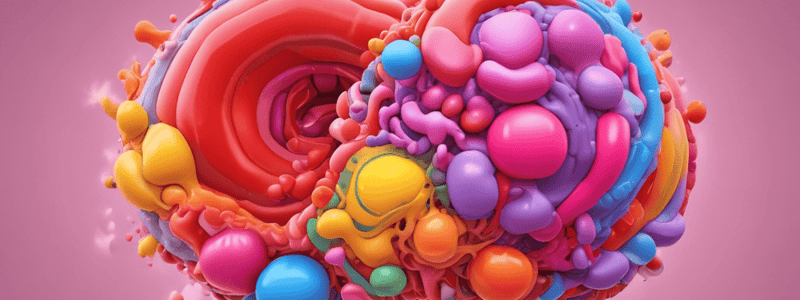Podcast
Questions and Answers
Which lipoprotein is responsible for transporting triglycerides from the intestine and liver?
Which lipoprotein is responsible for transporting triglycerides from the intestine and liver?
- LDL
- HDL
- VLDL
- Chylomicrons (correct)
What is the precursor to many compounds such as bile acids and steroid hormones?
What is the precursor to many compounds such as bile acids and steroid hormones?
- Cholesterol esters (correct)
- HDL
- LDL
- VLDL
What happens to plasma triglyceride levels after a fatty meal?
What happens to plasma triglyceride levels after a fatty meal?
- Decrease immediately
- Remain increased for several hours (correct)
- Depend on the type of fat consumed
- Return to normal levels quickly
What type of fatty acids are solid at room temperature and generally come from animal products?
What type of fatty acids are solid at room temperature and generally come from animal products?
Which type of fatty acid contains more than one carbon-carbon double bond and is generally from plants?
Which type of fatty acid contains more than one carbon-carbon double bond and is generally from plants?
What is the primary cause of LDL particle uptake by macrophages in artery walls?
What is the primary cause of LDL particle uptake by macrophages in artery walls?
What occurs when collagen overlies foam cells in the artery wall?
What occurs when collagen overlies foam cells in the artery wall?
Which is a harmful type of fatty acid produced by hydrogenation of fats for a longer shelf life?
Which is a harmful type of fatty acid produced by hydrogenation of fats for a longer shelf life?
What is the fate of lipid droplets that accumulate beneath the fibrous cap in atherosclerosis?
What is the fate of lipid droplets that accumulate beneath the fibrous cap in atherosclerosis?
What is the main source of cholesterol esters in plasma?
What is the main source of cholesterol esters in plasma?
What are Omega 3 and Omega 6 considered to be?
What are Omega 3 and Omega 6 considered to be?
Why do essential fatty acids need to be consumed in the diet?
Why do essential fatty acids need to be consumed in the diet?
What is the main clinical feature of Familial Hypercholesterolemia (FH)?
What is the main clinical feature of Familial Hypercholesterolemia (FH)?
What do cholesterol values in individuals with FH typically show?
What do cholesterol values in individuals with FH typically show?
Which condition is NOT a common cause of Secondary Hypertension?
Which condition is NOT a common cause of Secondary Hypertension?
Which factor does NOT contribute to the pathophysiology of essential hypertension?
Which factor does NOT contribute to the pathophysiology of essential hypertension?
What is the main risk factor associated with Secondary Hypertension?
What is the main risk factor associated with Secondary Hypertension?
What is a characteristic feature of Malignant Hypertension?
What is a characteristic feature of Malignant Hypertension?
What is one of the common features seen in Primary Hypercholesterolemia?
What is one of the common features seen in Primary Hypercholesterolemia?
What is one of the causes of Secondary Hypertension?
What is one of the causes of Secondary Hypertension?
What is the most common genetic disease in Europe?
What is the most common genetic disease in Europe?
Which factor contributes to the pathophysiology of essential hypertension through alterations to vascular tone & structure?
Which factor contributes to the pathophysiology of essential hypertension through alterations to vascular tone & structure?
What is the main clinical feature of Primary Hypercholesterolemia?
What is the main clinical feature of Primary Hypercholesterolemia?
In the Dutch lipid clinic network, what point range indicates 'probable Familial Hypercholesterolemia'?
In the Dutch lipid clinic network, what point range indicates 'probable Familial Hypercholesterolemia'?
Which condition is NOT a common cause of Secondary Hypertension?
Which condition is NOT a common cause of Secondary Hypertension?
What happens to blood pressure levels in Malignant Hypertension?
What happens to blood pressure levels in Malignant Hypertension?
What do Omega 3 and Omega 6 fatty acids serve as precursors to?
What do Omega 3 and Omega 6 fatty acids serve as precursors to?
What is the primary fate of LDL particles that cross damaged endothelium in the pathogenesis of atherosclerosis?
What is the primary fate of LDL particles that cross damaged endothelium in the pathogenesis of atherosclerosis?
Which type of fatty acids generally come from plants and are oils at room temperature?
Which type of fatty acids generally come from plants and are oils at room temperature?
Which characteristic is NOT associated with saturated fatty acids?
Which characteristic is NOT associated with saturated fatty acids?
What is the main precursor to compounds such as bile acids and steroid hormones?
What is the main precursor to compounds such as bile acids and steroid hormones?
In the context of atherosclerosis, what occurs after collagen overlies foam cells in the artery wall?
In the context of atherosclerosis, what occurs after collagen overlies foam cells in the artery wall?
Which lipid is esterified with fatty acids to form cholesterol esters in plasma?
Which lipid is esterified with fatty acids to form cholesterol esters in plasma?
What lipid type is made of a glycerol molecule and three fatty acids?
What lipid type is made of a glycerol molecule and three fatty acids?
Which lipid component serves as a precursor to many compounds including steroid hormones?
Which lipid component serves as a precursor to many compounds including steroid hormones?
What happens to plasma triglyceride levels following the consumption of a fatty meal?
What happens to plasma triglyceride levels following the consumption of a fatty meal?
What is the primary cause of LDL particle uptake by macrophages in the artery walls?
What is the primary cause of LDL particle uptake by macrophages in the artery walls?
What lipoprotein is responsible for transporting triglycerides from the intestine and liver?
What lipoprotein is responsible for transporting triglycerides from the intestine and liver?
What occurs when collagen overlies foam cells in the artery wall?
What occurs when collagen overlies foam cells in the artery wall?
What happens to plasma triglyceride levels following the consumption of a fatty meal?
What happens to plasma triglyceride levels following the consumption of a fatty meal?
What lipid component serves as a precursor to many compounds including steroid hormones?
What lipid component serves as a precursor to many compounds including steroid hormones?
Which lipoprotein is primarily responsible for transporting cholesterol esters in the plasma?
Which lipoprotein is primarily responsible for transporting cholesterol esters in the plasma?
What is the main characteristic of trans-unsaturated fatty acids?
What is the main characteristic of trans-unsaturated fatty acids?
What is the primary effect of necrosis or apoptosis in the pathogenesis of atherosclerosis?
What is the primary effect of necrosis or apoptosis in the pathogenesis of atherosclerosis?
Which type of fatty acids generally come from plants and contain more than one carbon-carbon double bond?
Which type of fatty acids generally come from plants and contain more than one carbon-carbon double bond?
What is the fate of plasma triglyceride levels following the consumption of a fatty meal?
What is the fate of plasma triglyceride levels following the consumption of a fatty meal?
Flashcards are hidden until you start studying
Study Notes
Omega Acids and Essential Fatty Acids
- Omega acids are unsaturated essential fatty acids, e.g., Omega 3 and Omega 6, which are precursors to prostaglandins, thromboxane, and leukotrienes.
- Essential fatty acids cannot be synthesized by humans and must be consumed in the diet.
Hypercholesterolemia
- Primary Hypercholesterolemia, also known as polygenic hypercholesterolemia, is characterized by high levels of cholesterol that increase the risk of cardiovascular disease (CVD).
- Familial Hypercholesterolemia is the most common genetic disease in Europe, affecting 1 in 300 people, and is a leading cause of premature coronary heart disease (CHD).
- Clinical features of Familial Hypercholesterolemia include xanthomata, xanthelasma, and corneal arcus.
- Laboratory diagnosis of Familial Hypercholesterolemia involves measuring cholesterol levels, with 1 in 25 people having cholesterol levels >7 mmol/L.
Hypertension
- Blood pressure (BP) is the product of blood volume and peripheral vascular resistance.
- Pathophysiology of essential hypertension involves environmental factors, genetic factors, and alterations to vascular tone and structure, leading to impaired renal function and excessive sympathetic nervous system activation.
- BP >140/90mmHg increases the risk of mortality from cerebrovascular hemorrhage, fatal cardiac arrhythmias, heart failure, aortic dissection, and renal failure.
- Organ damage increases with age, in African Americans, and in people with co-morbidities.
Secondary Hypertension
- Causes 5% of hypertension cases.
- Caused by primary hyperaldosteronism (Conn's syndrome), thyrotoxicosis, pregnancy (pre-eclampsia), coarctation of the aorta, drug-induced, renal parenchymal disease, and reno-vascular hypertension due to renal artery stenosis.
Essential vs Malignant Hypertension
- Essential hypertension is characterized by slow progression, hyaline arteriosclerosis, and muscular thickening of larger arteries.
- Malignant hypertension is less common, with a sudden rise in BP and rapid progression, leading to fibrinoid necrosis and myointimal proliferation of small vessels.
Dyslipidemia
- Lipid terminology:
- Lipoproteins: soluble complex of lipid and protein found in body fluids, including chylomicrons, VLDL, LDL, and HDL.
- Cholesterol: hydroxyl group, steroid nucleus, and hydrocarbon tail, precursor to many compounds (bile acids and steroid hormones).
- Triglycerides: lipid made of glycerol molecule and 3 fatty acids, transported from intestine and liver in lipoprotein particles.
- Fatty acids: straight chain carbon compounds of varying length, esterified, non-esterified, or free.
Pathogenesis of Atherosclerosis
- Endothelial damage leads to LDL particles crossing the damaged endothelium, attracting circulating monocytes, and oxidation of LDL particles in the artery wall.
- Macrophages take up oxidized LDL particles, leading to foam cell formation, collagen overlay, and necrosis or apoptosis.
- This leads to the formation of a pool of extracellular cholesterol trapped beneath a fibrous cap, which advances across the inner surface of the artery, causing plaques to obstruct blood flow (ischemia) or rupture (thrombus formation).
Studying That Suits You
Use AI to generate personalized quizzes and flashcards to suit your learning preferences.




